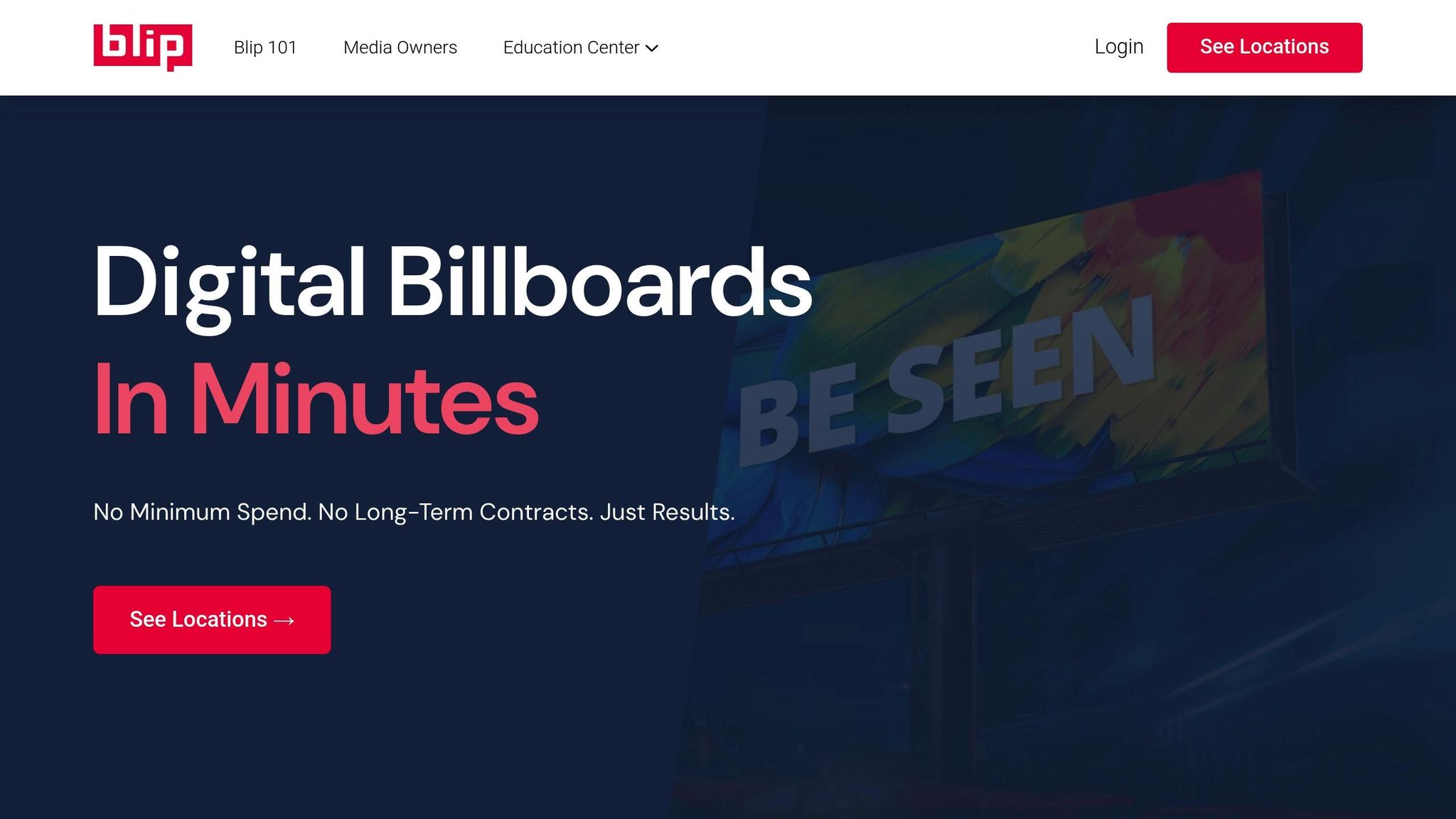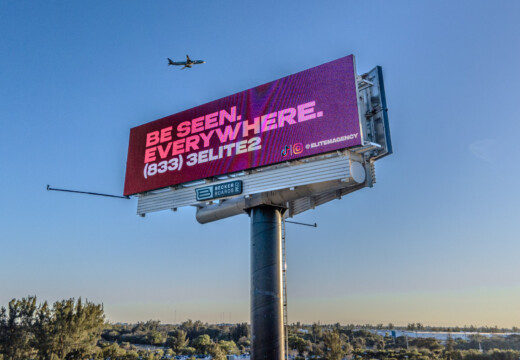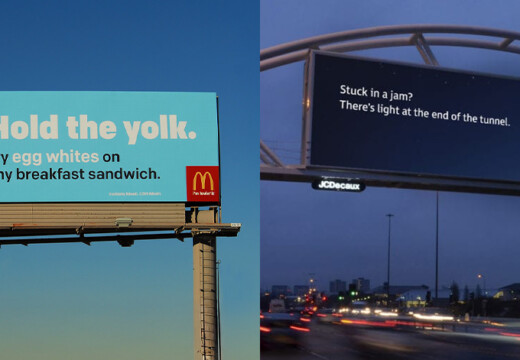Tracking the ROI of out-of-home (OOH) and digital ads can seem complex, but it boils down to combining clear goals, measurable metrics, and the right tools. Here’s how you can do it effectively:
- Set Clear Goals: Focus on objectives like brand visibility, store traffic, online engagement, and sales growth.
- Track Key Metrics: Use specific indicators like impressions, foot traffic, website visits, and conversions to measure success.
- Use Tools to Connect OOH and Digital: QR codes, custom URLs, geofencing, and platforms like Blip help link physical ads to digital actions.
- Analyze Data to Optimize Campaigns: Monitor cost per thousand impressions (CPM), conversion rates, and timing to refine strategies.
Setting Campaign Goals and Success Metrics
Choosing Campaign Goals
Define clear, measurable objectives to evaluate ROI across both OOH and digital advertising efforts. Kimberly Pinkson, owner of Pretty In Pinkston, highlighted the impact of billboard advertising on standing out in the market:
“Blip works for us. It’s a different medium, and it brings a lot of exposure. It sets us apart from the rest of the [competition], and that’s what I like.”
Focus on these key areas to guide your campaign:
- Brand Visibility: Measure impressions and reach across physical and digital platforms.
- Store Traffic: Track increases in foot traffic and in-store visits.
- Online Engagement: Monitor website visits, social media activity, and digital conversions.
- Sales Growth: Evaluate revenue changes during the campaign period.
Once your goals are set, outline the specific metrics that will help you measure progress.
Essential Metrics to Monitor
Choose metrics that align with your campaign goals. Here’s a breakdown of key performance indicators for OOH and digital channels:
| Metric Category | OOH Indicators | Digital Indicators |
|---|---|---|
| Exposure | Daily plays, Billboard impressions | Page views, Ad impressions |
| Engagement | Pedestrian traffic, Vehicle counts | Click-through rates, Time on site |
| Conversion | Store visits, Direct phone calls | Online purchases, Form submissions |
| Brand Impact | Aided/unaided recall, Brand lift | Social mentions, Search volume |
By defining these metrics, you can combine offline and online data to get a complete picture of your campaign’s effectiveness.
Connecting OOH and Digital Metrics
Chris Leslie, founder of Leslie Lightcraft Co, emphasizes the role of billboard advertising in boosting brand visibility. To measure cross-channel success, integrate data from physical visits, website traffic spikes, social media engagement, and sales patterns tied to your campaign.
Start by setting baseline metrics before launch, then track consistently throughout the campaign. This approach ensures accurate attribution and helps calculate ROI across both traditional and digital platforms.
Track Billboard ROI: Impossible or Achievable?
Tools for Cross-Channel Performance Tracking
Advertisers today need effective tools to measure how their campaigns perform across both outdoor and digital platforms. Below are some of the best ways to track cross-channel results using reliable tools that align with your digital campaign strategy.
QR Codes and Custom URLs
Incorporating QR codes or custom URLs into outdoor ads makes it easier to track direct responses from billboard viewers. These tools create a clear link between physical ad exposure and online engagement. Here’s how you can make the most of them:
- Add UTM parameters to track traffic from specific billboards.
- Design location-specific landing pages for each outdoor ad.
- Monitor scan rates and URL visits during ad display periods.
- Track conversions driven by billboard-sourced traffic.
For better results, place QR codes at a convenient height for easy scanning and keep URLs short and easy to remember for manual entry.
Location Data and Movement Patterns
Geographic data is a powerful way to connect outdoor ad exposure to real-world actions. Here’s a breakdown of modern tracking methods and the insights they provide:
| Tracking Method | What It Measures | Insights Gained |
|---|---|---|
| Mobile Location | Audience movement patterns | Store visit attribution |
| Traffic Counts | Vehicle exposure | Estimating ad reach |
| Foot Traffic | Pedestrian activity | Impact on store visits |
| Geofencing | Digital engagement near ads | Cross-channel attribution |
By studying movement patterns before and during campaigns, advertisers can gauge how outdoor ads influence consumer behavior.
Blip‘s Performance Dashboard

Blip’s analytics platform delivers real-time data to help advertisers measure billboard campaign performance and ROI. According to Ray Bowens, Founder of Hashtag-Vape:
“Billboards are one of the most impactful ways to advertise, and with Blip, you spend a fraction of what you would end up paying elsewhere.”
The dashboard provides key metrics such as:
- Daily play counts and impression estimates
- Real-time bidding performance
- Engagement rates by location
- Cost per thousand impressions (CPM)
- Budget utilization tracking
With updates every 10 minutes, the platform allows advertisers to make quick, informed decisions based on up-to-date campaign data.
sbb-itb-2e2e93f
Making Sense of Campaign Data
Analyze the combined impact of Out-of-Home (OOH) advertising and digital data to understand the overall effectiveness of your campaign.
Linking Billboard Views to Online Actions
Pay close attention to how timing and location influence spikes in digital engagement after billboard displays. For instance, Mr. Charlie’s observed a clear connection between their billboard ads and website traffic trends. Paul Willey, Owner of Mr. Charlie’s, explained:
“Working with Blip has given Mr. Charlie’s the momentum to get our new location on the map while accelerating growth for our original location”
Key metrics to evaluate during billboard display periods include:
| Timing | Online Metrics | Ad Context |
|---|---|---|
| During Display Hours | Website Traffic Spikes | Active Billboard Locations |
| Peak Traffic Times | Search Volume Changes | Billboard Impression Counts |
| Post-Exposure | Store Location Searches | Geographic Coverage |
| Campaign Duration | Direct URL Visits | Total Play Count |
These insights help connect billboard exposure to digital responses, providing a clear picture of cost-efficiency across advertising channels.
Comparing Channel Costs and Results
To determine the cost-effectiveness of each channel, compare metrics like CPM, conversion rates, and geographic performance. Focus on these key performance indicators:
- Cost per thousand impressions (CPM) for each channel
- Conversion rates during billboard display periods
- Variations in geographic performance
- Effectiveness based on time of day
- Efficiency in budget utilization
Case Studies: ROI Measurement
Case studies highlight the importance of tracking daily impressions, website traffic, and store visits to measure ROI effectively. For example, Hashtag-Vape experienced a strong return on their billboard investment. Founder Ray Bowens shared:
“Billboards are one of the most impactful ways to advertise, and with Blip, you spend a fraction of what you would end up paying elsewhere.”
Success indicators include:
- Daily impression counts from billboard ads
- Increases in website traffic during display times
- Growth in store visits during campaigns
- Changes in brand search volume
- Spikes in social media mentions during billboard display periods
Improving Campaigns with Data
Use data-driven insights to fine-tune strategies and boost campaign performance across various channels.
Adjusting Channel Budgets
Analyze performance metrics to redistribute budgets effectively between OOH (out-of-home) and digital platforms:
| Metric Type | What to Monitor | Action Items |
|---|---|---|
| Cost Efficiency | CPM trends, daily impression costs | Allocate more budget to lower CPM areas |
| Engagement | Website traffic spikes, conversion rates | Increase spend during high-traffic periods |
| Geographic Impact | Location-based response rates | Prioritize areas with strong performance |
| Timing Effects | Time-of-day performance | Schedule displays for peak ROI periods |
Testing Ad Elements
Experiment with creative elements and placements to identify what resonates most with your audience:
- Visual Impact: Test layouts, color schemes, and font sizes.
- Message Clarity: Evaluate calls-to-action and value propositions.
- Location Performance: Assess billboard positions and angles for visibility.
- Timing Patterns: Experiment with display schedules and durations.
Testing provides actionable insights that help advertisers make quick, informed adjustments to improve engagement and visibility.
Quick Changes with Blip
Blip’s tools for real-time bidding and creative updates make it easy to adapt campaigns on the fly:
- Start with a small daily budget (as low as $20) to test performance.
- Adjust pricing every 10 minutes using real-time bidding.
- Track daily impression counts to refine timing strategies.
- Update creative elements based on audience response data.
| Strategy | Implementation | Benefit |
|---|---|---|
| Dynamic Budgeting | Adjust daily spend based on metrics | Maximize ROI during peak periods |
| Location Testing | Rotate billboard placements | Identify the best-performing locations |
| Creative Iteration | Revise designs using response data | Improve visual appeal and engagement |
| Schedule Optimization | Align timing with traffic patterns | Target key viewing times effectively |
Conclusion: Getting the Most from OOH and Digital
Measuring ROI for OOH and digital ads involves combining accurate tracking with smart, data-informed strategies. Industry experts highlight that OOH advertising’s bold visibility can boost public engagement, offering businesses a chance to make a big impact while keeping costs under control.
| Strategy | How to Implement | Outcome |
|---|---|---|
| Cross-Channel Tracking | Merge billboard analytics with digital data | Holistic performance insights |
| Dynamic Budget Management | Adjust bids in real time (every 10 minutes) | Better budget efficiency |
| Performance Monitoring | Track daily impressions and responses | Refine campaigns based on data |
| Creative Testing | Use A/B testing across platforms | Improve audience interaction |
These methods highlight how OOH and digital approaches can work together effectively. Integrated campaigns can deliver clear results, as shown by Mr. Charlie’s Chicken Fingers. Owner Paul Willey shared:
“Working with Blip has given Mr. Charlie’s the momentum to get our new location on the map while accelerating growth for our original location”
For businesses aiming to boost their advertising ROI, today’s tools make it easier to:
- Monitor campaign performance in real time
- Adjust strategies based on actionable insights
- Make an impact with as little as $20 per day
- Scale successful campaigns across multiple locations
FAQs
How can I use QR codes and custom URLs in my OOH campaigns to measure digital engagement?
Integrating QR codes and custom URLs into your out-of-home (OOH) campaigns is a smart way to track digital engagement and measure ROI. By including a QR code or a short, easy-to-remember URL on your billboard, you can guide viewers to specific landing pages, promotions, or digital content, while also gathering valuable data on user interactions.
To maximize effectiveness, ensure your QR codes are large enough to scan from a distance and place them in high-visibility areas of your design. For URLs, use custom links or URL shorteners to make them simple and memorable. Once your campaign is live, use analytics tools to track metrics like click-through rates, page visits, and conversions, giving you actionable insights into how your OOH ads drive digital engagement.
What metrics should I track to measure the ROI of OOH and digital ad campaigns?
To effectively measure the ROI of your combined OOH (out-of-home) and digital advertising campaigns, focus on a few key metrics:
- Impressions: Track how many people are exposed to your ads. For OOH, this is often based on traffic data, while digital platforms provide precise impression counts.
- Engagement: For digital ads, monitor clicks, likes, shares, or other interactions that show audience interest.
- Conversions: Measure specific actions, such as purchases, sign-ups, or inquiries, to assess the direct impact of your campaign.
- Cost Per Result: Calculate how much you’re spending for each conversion or impression to evaluate cost-efficiency.
Platforms like Blip make it easy to monitor these metrics by providing robust analytics tools, so you can adjust your campaigns in real-time for better performance and ROI. By combining data from both OOH and digital channels, you can gain a comprehensive view of your campaign’s success.
How can geofencing and location data help boost the ROI of my billboard ads?
Geofencing and location data can significantly enhance the ROI of your billboard advertising by allowing you to target and measure your audience more effectively. By setting up virtual boundaries around specific areas, you can track when individuals within these zones are exposed to your ads and analyze their behavior, such as visiting your store or website.
This data helps you refine your campaign strategy by identifying which locations and times generate the best results. For example, combining geofencing with digital billboards lets you adjust your ad placements dynamically based on audience movement patterns, ensuring your message reaches the right people at the right time. This targeted approach not only maximizes your ad spend but also provides valuable insights into customer engagement and campaign performance.
Related posts
- Digital Billboard ROI: Measuring Campaign Success
- How to Segment Audiences for OOH Campaigns
- Geo-Analytics for Billboard ROI
Integrating QR codes and custom URLs into your out-of-home (OOH) campaigns is a smart way to track digital engagement and measure ROI. By including a QR code or a short, easy-to-remember URL on your billboard, you can guide viewers to specific landing pages, promotions, or digital content, while also gathering valuable data on user interactions.
\n
To maximize effectiveness, ensure your QR codes are large enough to scan from a distance and place them in high-visibility areas of your design. For URLs, use custom links or URL shorteners to make them simple and memorable. Once your campaign is live, use analytics tools to track metrics like click-through rates, page visits, and conversions, giving you actionable insights into how your OOH ads drive digital engagement.
"}},{"@type":"Question","name":"What metrics should I track to measure the ROI of OOH and digital ad campaigns?","acceptedAnswer":{"@type":"Answer","text":"
To effectively measure the ROI of your combined OOH (out-of-home) and digital advertising campaigns, focus on a few key metrics:
\n
- \n
- Impressions: Track how many people are exposed to your ads. For OOH, this is often based on traffic data, while digital platforms provide precise impression counts.
- Engagement: For digital ads, monitor clicks, likes, shares, or other interactions that show audience interest.
- Conversions: Measure specific actions, such as purchases, sign-ups, or inquiries, to assess the direct impact of your campaign.
- Cost Per Result: Calculate how much you’re spending for each conversion or impression to evaluate cost-efficiency.
\n
\n
\n
\n
\n
Platforms like Blip make it easy to monitor these metrics by providing robust analytics tools, so you can adjust your campaigns in real-time for better performance and ROI. By combining data from both OOH and digital channels, you can gain a comprehensive view of your campaign’s success.
"}},{"@type":"Question","name":"How can geofencing and location data help boost the ROI of my billboard ads?","acceptedAnswer":{"@type":"Answer","text":"
Geofencing and location data can significantly enhance the ROI of your billboard advertising by allowing you to target and measure your audience more effectively. By setting up virtual boundaries around specific areas, you can track when individuals within these zones are exposed to your ads and analyze their behavior, such as visiting your store or website.
\n
This data helps you refine your campaign strategy by identifying which locations and times generate the best results. For example, combining geofencing with digital billboards lets you adjust your ad placements dynamically based on audience movement patterns, ensuring your message reaches the right people at the right time. This targeted approach not only maximizes your ad spend but also provides valuable insights into customer engagement and campaign performance.
"}}]}


